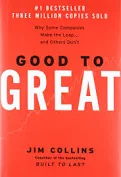Opening Up Options in Your Blog
In his business book Good to Great, Jim Collins writes that his favorite opening question when meeting a prospect is “Where are you from?” That opener allows the other person to respond in a myriad of ways, the author explains. The prospect might talk about her hometown or country – “I grew up in Berlin”, or about her employer – “I represent Fidelity Bank and Trust”, or reveal that she’s originally from LA, but has been living in the Midwest for most of her adult life. The concept is, as Daniel Pink mentions in his own book To Sell is Human, when talking to prospects, open things up rather than shutting them down by making people think you’re passing judgment on them.
When it comes to converting readers into customers, our job as blog content writers is to present choice, we stress at Say It For You. Given enough “space” to absorb the relevant and truthful information we present over time, consumers are perfectly able to – and far more likely to – decide to take action. Defining a problem, even when offering statistics about that problem, isn’t enough to galvanize prospects into action. But showing you not only understand the root causes of a problem, but have experience in providing solutions to very that problem can help drive the marketing process forward.
But what I don’t mean in advising you to present a variety of options is the “Swiss army knife” approach – you don’t want your blog to be an all-in-one marketing tool that forces a visitor to spend a long time just figuring out the 57 wonderful services your company has to offer!. What you can do with the blog is offer different kinds of information in different blog posts. I often remind business bloggers to provide several options to readers, including “read more”, “take a survey”, “comment”, or “subscribe”. On websites with no e-commerce options, of course, “Contact” might be the ultimate reader “compliance” step.
I think the important take-away from Collins’ “Where-are-you-from?” approach is that people are different. Action-oriented readers will want our best recommendations from among the choices. Idea-oriented persons will want to know about the business owners’ core beliefs underlying the way that business is structured. A process-oriented reader will want to know how the process of purchasing and using the product or service works.
To sell what you do and how you do it is human, but be sure to open up a variety of options in your blog!






Follow us online!